Small-to-middle Scale DCS [type2 light]
High Cost Performance DCS: type2 light
Meets Requirements for Compact C&I System
![Small-to-middle Scale DCS [type2 light]](/content/dam/toshiba/migration/infrasolution/www/infrastructure/industrial/assets/san-con-index_img_05.jpg)
For thirty five years or more, DCS products of Toshiba have been applied to process automation systems of power generation, water & wastewater, oil & gas, iron making, mining, chemical, paper & paper mill and cement. In general, the system requirements for conventional DCS are high reliability, high availability, advanced control performance and high capacity.
While a large scale DCS is able to manage a few thousands loops per controller, it is expensive to introduce into a plant because of the complex redundant architecture used to reduce the risk of centralized control and operation.
Nowadays global process automation market is looking for DCS products which are easier to introduce with improved cost performance in addition to the conventional DCS requirements.
One practical solutions is to introduce properly scaled DCS into each functional plant unit as needed. This reduces the risk of centralized control and operation with reasonable cost.
To meet these real needs Toshiba launches a small-to-middle scale DCS into the process automation market in 2015. The DCS, named type2 light, manages up to 1,000 tag objects including up to 128 control loops, while maintaining inherited functions from Toshiba's large scale DCS.
![Small-to-middle Scale DCS [type2 light] image](/content/dam/toshiba/migration/infrasolution/www/infrastructure/en/industrial/assets/spec2-2_img_01.jpg)
- * Unified Controller nv series is a trademark of Toshiba Corporation.
- * TC-net is a trademark of Toshiba Corporation.
- * Ethernet is a trademark of Xerox Corporation.
- * PROFIBUS is a trademark of PROFIBUS User Organization.
- * Modbus is a trademark of Schneider Automation Inc.
- * HART is a trademark of FieldComm Group.
- * Microsoft and Windows are either registered trademarks or trademarks of Microsoft Corporation in the United States and/or other countries.
High Cost Performance DCS: type2 light
High Cost Performance
Previous DCS of Toshiba, V-series L2, needs two sets of four modules at least in the main unit to realize redundancy.
The new DCS, type2 light needs only two sets of two modules to realize redundancy with lower power consumption achieved by using highly integrated technology.
Inheritance from Toshiba DCS
Succeeding to Toshiba DCS features of Industrial Dual Ethernet, Intelligent Serial I/O, IEC61131-3 Programming, Standard Process Tags and Real Time Database of ONS Sever, type2 light fits into the existing TOSDIC-CIE/DS system, migrating from legacy DCS and utilizing existing user programs.
Sufficient Tag Object Capacity for Small-to-Middle Scale Plant Unit
Up to 1000 process tag objects consisting of 384 indicators, 128 controllers and 512 discrete devices are available, so that type 2 light is suitable for most of small-to-middle scale plant units.
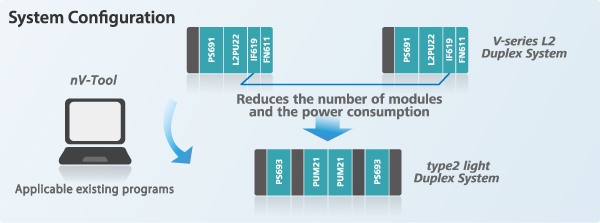
System Specification of type2 light
This table can be scrolled horizontally.
| Category | Item | Description |
|---|---|---|
| Main Unit | Redundancy | Single or duplex |
| Cooling | Natural air cooling without Fan | |
| CPU | Bit Length | 32bit |
| Ethernet | Interface | RJ45 2 Ports, 100BASE-TX |
| Supported Functions | OIS-DS connection (ONS-Server), Communication between controllers, nV-Tool connection | |
| I/O | Supported I/O subsystem | TC-net I/O, Intelligent Serial I/O |
| The number of TC-net I/O Modules | 256 modules | |
| Intelligent Serial I/O Interface | SMB21 Module, D-Sub 9 pin 2 ports, Two Intelligent Serial I/O Buses Connectable | |
| The number of intelligent Serial I/O Modules | 420 modules | |
| User Program | Program language | IEC61131-3, LD, FBD, SFC, ST |
| Program code capacity | 128 K steps | |
| Program variable capacity | Global variables plus Local variables, Total 64KW | |
| Program executing task | Event (EV) 8, Interrupt (IP) 8, High speed scan (HS) 8, Main scan (MS) 64 | |
| Program executing time | HS:10-500ms(1ms unit), MS:100-1000ms(10ms unit) | |
| Tag | Supported Objects | Indicator:384, Controller:128, PB & Lamp:512, Timer/Counter:64, Sequence Unit:64, Data Setting:128, PLN Table:128, Timer:256, Counter:128, Integer:640, Real:2048, Real time trend:512 |
Multivendor & High Speed Remote I/O: TC-net I/O
High Speed Definite Response, Optical Networking and Online Maintenance
type2 light communicates with TC-net I/O Adapters via TC-net I/O Loop based on 100 Mbps Ethernet. TC-net I/O Adapter communicates with TC-net I/O Modules via 10 Mbps TC-net I/O Bus. This system, utilizing TC-net for each layer, enables high speed defined response and remote I/O. TC-net I/O Loop uses a ring topology and does not need any Ethernet switching hub which can be a bottleneck to system reliability due to the hub being a centralized active module connecting several stations.In addition, this loop network is able to continue communication to every station even if a cable connection is broken.
For this reason, it is possible to add remote I/O stations or I/O modules online. And furthermore, the TC-net I/O loop is configurable by using not only electrical cables but also optical ones, so that electrical-isolated remote I/O system can be realized.
Multivendor Networking
I/O system of previous DCS, V-series L2, is Intelligent Serial I/O, which supports direct I/O modules to perform analog/digital input/output. TC-net I/O provides multi roles of input/output from/to 3rd party devices via Modbus, FL-net, Profibus-DP, HART as well as native direct I/O, so that a multivendor networking DCS can be built.
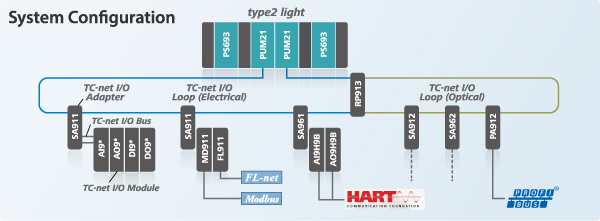
System Specification of TC-net I/O
This table can be scrolled horizontally.
| Category | Item | Description |
|---|---|---|
| TC-net I/O Loop | Network Redundancy | Single loop, Continuous communication even if a network connection is broken |
| Network Length | Electrical: 10m between stations, total 100m, Optical: 2km between stations ,total 4km | |
| Communication Speed | 100Mbps | |
| The number of I/O Adapters | Up to 16 per station | |
| Redundancy | Single | |
| TC-net I/O Bus | Network Redundancy | Dual |
| Network Length | 5m, both ends shall be connected by terminators | |
| Communication Speed | 10Mbps | |
| TC-net I/O Module | The number of Modules | 16 per TC-net I/O Bus, 256 per type2 light, except total 16 MD911 plus FL911 per type2 light |
| Redundancy | Single | |
| Third- party connection | Modbus, FL-net, Profibus-DP, HART (Supported in future) |
C&I Engineer-Oriented Programming: nV-Tool
C&I Engineer-Oriented
In C&I engineering, the instrument loop diagram has been the foundation of system requirements for control application.
Nowadays IEC61131-3 programming is supported by most of DCS as well as PLC. There are big differences between instrument loop diagram and IEC61131-3 one, so that most of C&I engineers and programmers have been struggling with the double maintenance this creates. To reduce the problem, nV-Tool supports Custom Symbols which are attachable to any Function Block of IEC61131-3. By preparing Custom Symbols of field devices and instrument balloons and attaching to functions blocks, you can draw, download and monitor instrument loop diagrams by using these symbols.
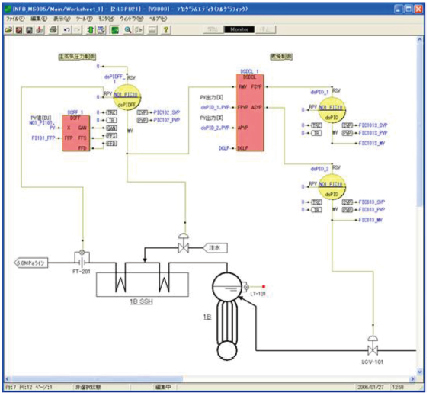
IEC61131-3 Standard
IEC61131-3 is an international standard of control programming language and structure. type2 light supports four well-known languages, as follows.
- LD: Ladder Diagram
- FBD: Function Block Diagram
- SFC: Sequential Function Chart
- ST: Structured Text
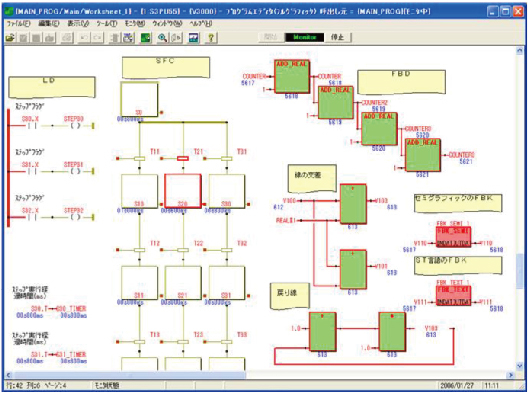
Integrated HMI for Small-to-Middle Scale: OIS-DS/Smart
Toshiba has been supplying DCS products of DPCS/MCS in eighties, PCS/PCS-DS/V-series L2/L3 in nineties, nv-series type2 in 2007. And furthermore, a new DCS for small-to-middle scale plant unit, type2 light, has been launched into the process automation market in 2015. OIS-DS is an Integrated HMI subsystem which supervises all the Toshiba DCS shown above.
In addition the functions of OIS-DS have been enhanced to supervise not only Toshiba DCS but also 3rd party PLC, by adding redundant PLCS (PLC Server) into the system in 2010s. OIS-DS is a large scale HMI which manages up to 20,000 tag objects, using up to 22 displays. Inheriting the functions of OIS-DS, OIS-DS/Smart is a high cost performance HMI package for small-to-middle scale system which supervises up to 4096 process tags, using up to 8 displays.
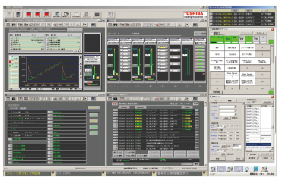
(Caution)
- Unified Controller nv series is a trademark of Toshiba Corporation.
- Other company names and product names herein are trademarks or registered trademarks of the companies concerned.
- The information contained herein is as of June, 2016.
- The information contained herein is subject to change without notice.
- The information contained herein is presented only as a guide for the applications of our products. No responsibility is assumed by TOSHIBA for any infringements of patents or other rights of the third parties which may result from its use. No license is granted by implication or otherwise under any patent or patent rights of TOSHIBA or others.
- TOSHIBA products should not be embedded to the downstream products which are prohibited to be produced and sold, under any law, and regulations.
- TOSHIBA does not take any responsibility for incidental damage (including loss of business profit, business interruption, loss of business information, and other pecuniary damage) arising out of the use or disability to use TOSHIBA products.
- Please use the product properly after thoroughly reading and understanding the instruction manual.
- Export or provision to overseas of this product is restricted by foreign exchange law and foreign trade law.
- This product is under restriction of US Export Administration Act, and permission from US government is necessary for export depending on the exporting destination.
- This product is not manufactured for systems that is directly related to human lives such as described below. If you need to use this product for such purpose, please contact our sales representative.
[Example]
- The propulsion machinery control system of a nuclear power plant, safety protection system of a nuclear facility, and any other systems important to safety
- Control system of collective transport system operation and air traffic control system
- Medical control system that is related to human lives



